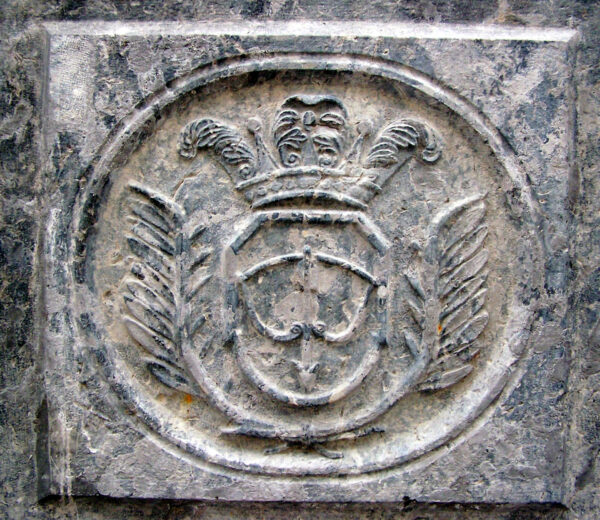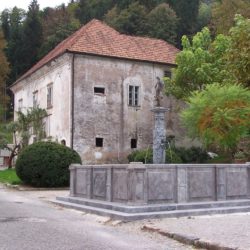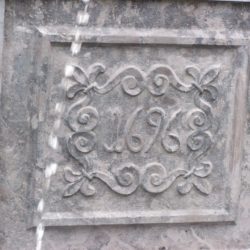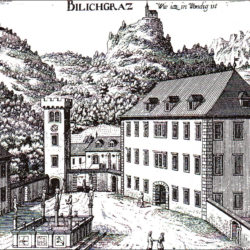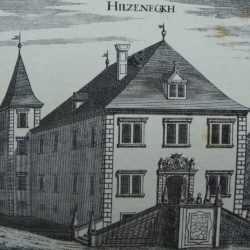
Coat of arms of the Barons Billichgrätz in Polhov Gradec
POLHOV GRADEC, MANOR
Location of the coat of arms: façade
The Neptune Fountain in front of the entrance to Polhov Gradec Manor (Billichgra(t)z) displays a carved coat of arms with a drawn bow pointing downward. The coat of arms is suggestive of the medieval lords of Billichgrätz, first documented in the early thirteenth century. Being the Spanheims’ loyal ministeriales secured the family a rapid social rise. Later, they entered the service of the Counts of Gorizia-Tyrol, holding various offices in Ljubljana. The family estate comprised, among other things, two castle buildings in Polhov Gradec and its immediate surroundings, both of which eventually fell to ruin. The family suffered an economic decline from the mid-fourteenth century onward and became extinct with the death of Johann von Billichgrätz at the end of the fifteenth century.
Nonetheless, rather than the medieval Billichgrätzes, the coat of arms on the fountain is directly associated with their early modern successors—the Kunstls. Originally a family of farmers from Pungert (Germ. Baumgarten) near Škofja Loka (Germ. Bischoflack), the Kunstls moved to Škofja Loka in the sixteenth century and built a fortune from ironworks and iron trade. In the early seventeenth century, Georg Kunstl (died in 1639) settled in Ljubljana, where he was granted the status of a townsman and elected repeatedly as town councilor, judge, and mayor. Having amassed more wealth through wine trade, he purchased several houses in the town and lent money on several occasions to the Carniolan provincial estates. On Georg’s death in 1646, his brother Johann (he died in 1659 and his line became extinct in the mid-eighteenth century) and son Markus Anton (1636–1693) were raised to nobility with the predicate Baumgarten. The ennoblement was due partly to the family’s economic prowess and partly to the military merit of some of its members who fought in the Thirty Years’ War and other Habsburg wars.
Abandoning his father’s trade, Markus Anton ventured into financial business and purchased several estates, the most important being the seigniory of Polhov Gradec. He—and especially his descendants—married into prominent noble families in Carniola, which secured him membership in the Carniolan provincial estates in 1660. In 1684, Emperor Leopold I elevated Mark Anton to the hereditary rank of baron with the name Billichgrätz, which he was authorized to use instead of the old family name Kunstl. Along with the new title, the Barons Billichgrätz were also given a new coat of arms to replace the old, Kunstl coat of arms, which was granted to them on their ennoblement in 1646. The new one featured a golden bow pointing downward, a motif that the family borrowed from the coat of arms that formerly belonged to the extinct medieval Billichgrätzes. In this way, the name and the arms enabled the Barons Billichgrätz to establish a direct link to their medieval predecessors.
According to Johann Weikhard von Valvasor, who depicted Polhov Gradec in his historiographical work Die Ehre deß Hertzogthums Crain (Sln. Slava vojvodine Kranjske; The Glory of the Duchy of Carniola) at the end of the seventeenth century, the fountain displayed not one but two coats of arms—hence, apart from Billichgrätz’s (wrongly presented in the graphic print as turned to the sinister side instead of downward), there was also a coat of arms with a unicorn representing Markus Anton’s second wife, Johanna Sibila, née Gall-Rudolfseck. The Gall coat of arms is no longer there, perhaps as a result of the subsequent remodeling of the fountain, which may have been indicated by both the inscription of the year 1696, carved on the fountain, and the different position of the coat of arms—specifically, Valvasor drew the Billichgrätz (as well as Gall) coat of arms on the southern side of the fountain rather than its eastern side, where it can be seen today. What is more, judging from Valvasor’s graphic print, the Billichgrätz and Gall coats of arms were once also located above the entrance to Lesno Brdo Mansion (Hölzenegg) but were demolished along with the manor after the Second World War.
Sources:
Preinfalk, Miha: Plemiške rodbine na Slovenskem. 17. stoletje. 1. del – Od Billichgrätzov do Zanettijev. Ljubljana, 2014, pp. 9-18.
